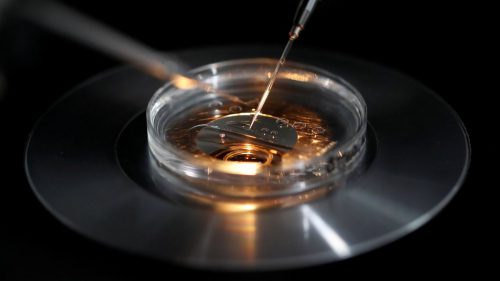

BreakPoint
A landmark book about intelligent design has hit the bookstore shelves. I’ll tell you about it.
BreakPoint: Signature in the Cell
A landmark book about intelligent design has hit the bookstore shelves. I’ll tell you about it.
 In recent years, there have been several important books about intelligent design that go to the debate about evolution and the origins of life. Bill Dembski’s The Design Inference was first. Then along came Darwin’s Black Box by Michael Behe, showing the irreducible complexity of the cell, which casts grave doubts on Darwinian evolution as an explanation for life and higher life forms.
Now we’ve got Signature in the Cell by the Discovery Institute’s Dr. Stephen Meyer.
I’m going to warn you up front: Signature in the Cell is not light reading. If you are not conversant in molecular biology, you might feel a bit overwhelmed at times.
But this is a profound, hugely important book for anybody interested in the scientific debate of our times—the origins of life. I feel it’s so important that we have posted an excerpt of the book at our website, BreakPoint.org, along with links to materials that will help you understand the main points of Signature in the Cell.
So what lies at the heart of Dr. Meyer’s Signature in the Cell is the concept of information. And, as scientists have learned, the very building block of life—molecular DNA—is a vast storehouse of information. Information in the form of a four-character chemical alphabet that, when precisely arranged, provides the “instructions” for forming proteins and the structures that living cells need to survive.
The key here is “precisely arranged.” I take three random English letters, say “O,” “G,” and “D.” The letters are building blocks for words, but they mean nothing unless arranged properly. If you arrange them one way, they spell “God.” Arrange them another way, and you get “dog.” In order to convey useful information, the letters have to be arranged precisely.
And that’s what DNA does. It contains and transmits the extraordinarily complex, precisely sequenced chemical code of life—a code that atheist Richard Dawkins has likened to computer code. Indeed, Bill Gates has said that “DNA is like a computer program, but far, far more advanced than any software ever created.”
Could such an “advanced” code, or “software for life,” have happened by chance? Well, as Dr. Meyer shows, given the vast complexity of information required to create the 250 proteins necessary to sustain the simplest living cell, the probability that life originated in the primordial soup by chance is beyond astronomically slim—only 1 in 10 to the 41 thousandth power!
But here is your takeaway, and I’ll let Dr. Meyer do the talking: “Our uniform experience affirms that specified information—whether inscribed in hieroglyphics, written in a book, encoded in a radio signal, or produced in a simulation experiment—always arises from an intelligent source, from a mind and not a strictly material process.”
“Indeed,” Dr. Meyer concludes, “it follows that the best, most causally adequate explanation for the origin of the specified, digitally encoded information in DNA is that it too had an intelligent source.”
No wonder most evolutionists refuse to debate intelligent design.
Thanks to Dr. Meyer, the debate about the origins of life is entering a new phase. Maybe we could say, for the chance theory of creation, that is, the writing is on the wall.
This commentary first aired on September 24, 2009.
In recent years, there have been several important books about intelligent design that go to the debate about evolution and the origins of life. Bill Dembski’s The Design Inference was first. Then along came Darwin’s Black Box by Michael Behe, showing the irreducible complexity of the cell, which casts grave doubts on Darwinian evolution as an explanation for life and higher life forms.
Now we’ve got Signature in the Cell by the Discovery Institute’s Dr. Stephen Meyer.
I’m going to warn you up front: Signature in the Cell is not light reading. If you are not conversant in molecular biology, you might feel a bit overwhelmed at times.
But this is a profound, hugely important book for anybody interested in the scientific debate of our times—the origins of life. I feel it’s so important that we have posted an excerpt of the book at our website, BreakPoint.org, along with links to materials that will help you understand the main points of Signature in the Cell.
So what lies at the heart of Dr. Meyer’s Signature in the Cell is the concept of information. And, as scientists have learned, the very building block of life—molecular DNA—is a vast storehouse of information. Information in the form of a four-character chemical alphabet that, when precisely arranged, provides the “instructions” for forming proteins and the structures that living cells need to survive.
The key here is “precisely arranged.” I take three random English letters, say “O,” “G,” and “D.” The letters are building blocks for words, but they mean nothing unless arranged properly. If you arrange them one way, they spell “God.” Arrange them another way, and you get “dog.” In order to convey useful information, the letters have to be arranged precisely.
And that’s what DNA does. It contains and transmits the extraordinarily complex, precisely sequenced chemical code of life—a code that atheist Richard Dawkins has likened to computer code. Indeed, Bill Gates has said that “DNA is like a computer program, but far, far more advanced than any software ever created.”
Could such an “advanced” code, or “software for life,” have happened by chance? Well, as Dr. Meyer shows, given the vast complexity of information required to create the 250 proteins necessary to sustain the simplest living cell, the probability that life originated in the primordial soup by chance is beyond astronomically slim—only 1 in 10 to the 41 thousandth power!
But here is your takeaway, and I’ll let Dr. Meyer do the talking: “Our uniform experience affirms that specified information—whether inscribed in hieroglyphics, written in a book, encoded in a radio signal, or produced in a simulation experiment—always arises from an intelligent source, from a mind and not a strictly material process.”
“Indeed,” Dr. Meyer concludes, “it follows that the best, most causally adequate explanation for the origin of the specified, digitally encoded information in DNA is that it too had an intelligent source.”
No wonder most evolutionists refuse to debate intelligent design.
Thanks to Dr. Meyer, the debate about the origins of life is entering a new phase. Maybe we could say, for the chance theory of creation, that is, the writing is on the wall.
This commentary first aired on September 24, 2009.
FURTHER READING AND INFORMATION
DNA, Darwin, and the Appearance of Design: Signature in the Cell
Dr. Stephen Meyer | BreakPoint Online | September 23, 2009
Signature in the Cell - Purchase | Book website
Dr. Stephen Meyer
Evolution News and Views
Discovery Institute
Evolution Narratives: A Letter to Swillpit
Regis Nicoll | BreakPoint Online | September 11, 2009
Information and Language: Evidences of the Creator
Regis Nicoll | BreakPoint Online | August 14, 2009
07/26/10















